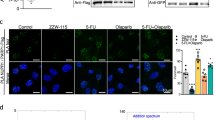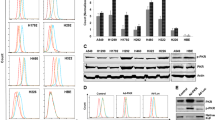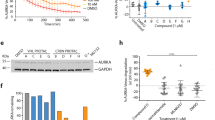Abstract
PARP1 inhibitors (PARPi) are known to kill tumor cells via two mechanisms (PARP1 catalytic inhibition and PARP1 trapping). The relative contribution of these two pathways in mediating the cytotoxicity of PARPi, however, is not well understood. Here we designed a series of small molecule PARP degraders. Treatment with one such compound iRucaparib-AP6 results in highly efficient and specific PARP1 degradation. iRucaparib-AP6 blocks the enzymatic activity of PARP1 in vitro, and PARP1-mediated poly-ADP-ribosylation signaling in intact cells. This strategy mimics PARP1 genetic depletion, which enables the pharmacological decoupling of PARP1 inhibition from PARP1 trapping. Finally, by depleting PARP1, iRucaparib-AP6 protects muscle cells and primary cardiomyocytes from DNA-damage-induced energy crisis and cell death. In summary, these compounds represent ‘non-trapping’ PARP1 degraders that block both the catalytic activity and scaffolding effects of PARP1, providing an ideal approach for the amelioration of the various pathological conditions caused by PARP1 hyperactivation.
This is a preview of subscription content, access via your institution
Access options
Access Nature and 54 other Nature Portfolio journals
Get Nature+, our best-value online-access subscription
$29.99 / 30 days
cancel any time
Subscribe to this journal
Receive 12 print issues and online access
$259.00 per year
only $21.58 per issue
Buy this article
- Purchase on Springer Link
- Instant access to full article PDF
Prices may be subject to local taxes which are calculated during checkout






Similar content being viewed by others
Data availability
The MS data have been deposited in the ProteomeXchange Consortium via the PRIDE partner repository with the dataset identifiers PXD014838 (Supplementary Dataset 1), PXD014836 and PXD014837 (Supplementary Datasets 2 and 3), PXD014840 (Supplementary Datasets 4 and 5), and PXD014839 (Supplementary Dataset 6). Source data for Figs. 2d, 5d and 6e,f, and Supplementary Fig. 12a–f are available online. Full uncropped blots are shown in Supplementary Fig. 14.
References
D’Amours, D., Desnoyers, S., D’Silva, I. & Poirier, G. G. Poly(ADP-ribosyl)ation reactions in the regulation of nuclear functions. Biochem. J. 342, 249–268 (1999).
Gibson, B. A. & Kraus, W. L. New insights into the molecular and cellular functions of poly(ADP-ribose) and PARPs. Nat. Rev. Mol. Cell Biol. 13, 411–424 (2012).
Hottiger, M. O. Nuclear ADP-ribosylation and its role in chromatin plasticity, cell differentiation, and epigenetics. Annu. Rev. Biochem. 84, 227–263 (2015).
Chambon, P., Weill, J. D. & Mandel, P. Nicotinamide mononucleotide activation of new DNA-dependent polyadenylic acid synthesizing nuclear enzyme. Biochem. Biophys. Res. Commun. 11, 39–43 (1963).
Gupte, R., Liu, Z. & Kraus, W. L. PARPs and ADP-ribosylation: recent advances linking molecular functions to biological outcomes. Genes Dev. 31, 101–126 (2017).
Liu, C., Vyas, A., Kassab, M. A., Singh, A. K. & Yu, X. The role of poly ADP-ribosylation in the first wave of DNA damage response. Nucleic Acids Res. 45, 8129–8141 (2017).
Bryant, H. E. et al. Specific killing of BRCA2-deficient tumours with inhibitors of poly(ADP-ribose) polymerase. Nature 434, 913–917 (2005).
Farmer, H. et al. Targeting the DNA repair defect in BRCA mutant cells as a therapeutic strategy. Nature 434, 917–921 (2005).
Pommier, Y., O’Connor, M. J. & de Bono, J. Laying a trap to kill cancer cells: PARP inhibitors and their mechanisms of action. Sci. Transl. Med. 8, 362ps317 (2016).
Lord, C. J. & Ashworth, A. PARP inhibitors: synthetic lethality in the clinic. Science 355, 1152–1158 (2017).
Berger, N. A. et al. Opportunities for the repurposing of PARP inhibitors for the therapy of non-oncological diseases. Br. J. Pharm. 175, 192–222 (2018).
Kam, T. I. et al. Poly(ADP-ribose) drives pathologic α-synuclein neurodegeneration in Parkinson’s disease. Science 362, eaat8407 (2018).
Shieh, W. M. et al. Poly(ADP-ribose) polymerase null mouse cells synthesize ADP-ribose polymers. J. Biol. Chem. 273, 30069–30072 (1998).
Yu, S. W. et al. Mediation of poly(ADP-ribose) polymerase-1-dependent cell death by apoptosis-inducing factor. Science 297, 259–263 (2002).
Wang, Y., Dawson, V. L. & Dawson, T. M. Poly(ADP-ribose) signals to mitochondrial AIF: a key event in parthanatos. Exp. Neurol. 218, 193–202 (2009).
Burslem, G. M. & Crews, C. M. Small-molecule modulation of protein homeostasis. Chem. Rev. 117, 11269–11301 (2017).
Ferraris, D. V. Evolution of poly(ADP-ribose) polymerase-1 (PARP-1) inhibitors. From concept to clinic. J. Med. Chem. 53, 4561–4584 (2010).
Thorsell, A. G. et al. Structural basis for potency and promiscuity in poly(ADP-ribose) polymerase (PARP) and tankyrase inhibitors. J. Med. Chem. 60, 1262–1271 (2017).
Yamanaka, H., Penning, C. A., Willis, E. H., Wasson, D. B. & Carson, D. A. Characterization of human poly(ADP-ribose) polymerase with autoantibodies. J. Biol. Chem. 263, 3879–3883 (1988).
Schwanhausser, B. et al. Global quantification of mammalian gene expression control. Nature 473, 337–342 (2011).
Galdeano, C. et al. Structure-guided design and optimization of small molecules targeting the protein–protein interaction between the von Hippel-Lindau (VHL) E3 ubiquitin ligase and the hypoxia inducible factor (HIF) alpha subunit with in vitro nanomolar affinities. J. Med. Chem. 57, 8657–8663 (2014).
Wahlberg, E. et al. Family-wide chemical profiling and structural analysis of PARP and tankyrase inhibitors. Nat. Biotechnol. 30, 283–288 (2012).
Knezevic, C. E. et al. Proteome-wide profiling of clinical PARP inhibitors reveals compound-specific secondary targets. Cell Chem. Biol. 23, 1490–1503 (2016).
Kronke, J. et al. Lenalidomide induces ubiquitination and degradation of CK1α in del(5q) MDS. Nature 523, 183–188 (2015).
An, J. et al. pSILAC mass spectrometry reveals ZFP91 as IMiD-dependent substrate of the CRL4CRBN ubiquitin ligase. Nat. Commun. 8, 15398 (2017).
Ishoey, M. et al. Translation termination factor GSPT1 is a phenotypically relevant off-target of heterobifunctional phthalimide degraders. ACS Chem. Biol. 13, 553–560 (2018).
Zhang, Y., Wang, J., Ding, M. & Yu, Y. Site-specific characterization of the Asp- and Glu-ADP-ribosylated proteome. Nat. Methods 10, 981–984 (2013).
Zhen, Y., Zhang, Y. & Yu, Y. A cell-line-specific atlas of PARP-mediated protein Asp/Glu-ADP-ribosylation in breast cancer. Cell Rep. 21, 2326–2337 (2017).
Pacher, P., Beckman, J. S. & Liaudet, L. Nitric oxide and peroxynitrite in health and disease. Physiol. Rev. 87, 315–424 (2007).
Gadd, M. S. et al. Structural basis of PROTAC cooperative recognition for selective protein degradation. Nat. Chem. Biol. 13, 514–521 (2017).
Murai, J. & Pommier, Y. PARP trapping beyond homologous recombination and platinum sensitivity in cancers. Annu. Rev. Cancer Biol. 3, 131–150 (2019).
Dawson, T. M. & Dawson, V. L. Mitochondrial mechanisms of neuronal cell death: potential therapeutics. Annu. Rev. Pharmacol. Toxicol. 57, 437–454 (2017).
Eliasson, M. J. et al. Poly(ADP-ribose) polymerase gene disruption renders mice resistant to cerebral ischemia. Nat. Med. 3, 1089–1095 (1997).
Yang, Z., Zingarelli, B. & Szabo, C. Effect of genetic disruption of poly(ADP-ribose) synthetase on delayed production of inflammatory mediators and delayed necrosis during myocardial ischemia-reperfusion injury. Shock 13, 60–66 (2000).
Zheng, J., Devalaraja-Narashimha, K., Singaravelu, K. & Padanilam, B. J. Poly(ADP-ribose) polymerase-1 gene ablation protects mice from ischemic renal injury. Am. J. Physiol. Ren. Physiol. 288, F387–F398 (2005).
Hoch, N. C. et al. XRCC1 mutation is associated with PARP1 hyperactivation and cerebellar ataxia. Nature 541, 87–91 (2017).
Li, B., Luo, C., Chowdhury, S., Gao, Z. H. & Liu, J. L. Parp1 deficient mice are protected from streptozotocin-induced diabetes but not caerulein-induced pancreatitis, independent of the induction of Reg family genes. Regul. Pept. 186, 83–91 (2013).
Pirinen, E. et al. Pharmacological inhibition of poly(ADP-ribose) polymerases improves fitness and mitochondrial function in skeletal muscle. Cell Metab. 19, 1034–1041 (2014).
Zhang, Q. J. et al. The histone trimethyllysine demethylase JMJD2A promotes cardiac hypertrophy in response to hypertrophic stimuli in mice. J. Clin. Invest. 121, 2447–2456 (2011).
Hu, R. et al. Quantitative secretomic analysis identifies extracellular protein factors that modulate the metastatic phenotype of non-small cell lung cancer. J. Proteome Res. 15, 477–486 (2016).
James, D. I. et al. First-in-class chemical probes against poly(ADP-ribose) glycohydrolase (PARG) inhibit DNA repair with differential pharmacology to olaparib. ACS Chem. Biol. 11, 3179–3190 (2016).
Acknowledgements
We thank J. A. Hill (UT Southwestern Medical Center) for sharing primary rat neonatal cardiomyocytes and X. Zhong and C. Kim for help with the immunofluorescence microscopy experiments and PARP1 immunoprecipitation experiments, respectively. We thank X. Yu (City of Hope) for providing the GFP-PARP1 construct. We also thank X. D. Wang, L. Yuan and the other members of the Yu laboratory for helpful discussions. This work was supported by grants from the National Institutes of Health (GM122932 to Y.Y. and CA226419 to C.C.) and the Welch foundation (I-1800 to Y.Y.).
Author information
Authors and Affiliations
Contributions
Y.Y. conceived the study and designed the overall strategy. L.H., C.C. and Y.Y. designed and synthesized the PARP1 degraders. S.W. and Y.Y. designed all the biochemical and cell biology experiments. S.W., J.H. and P.L. performed biochemical and cell biology experiments. S.W. and Q.D. performed quantitative MS. Q.-J.Z. and Z.-P.L. contributed reagents and technical advice. S.W. and Y.Y. analyzed and interpreted the data. S.W., L.H., C.C. and Y.Y. wrote the manuscript with input from all authors.
Corresponding authors
Ethics declarations
Competing interests
Y.Y. receives research support from Pfizer. A provisional patent application on the PARP degraders and technologies described herein has been filed by Y.Y., C.C., S. W. and L. H.
Additional information
Publisher’s note Springer Nature remains neutral with regard to jurisdictional claims in published maps and institutional affiliations.
Supplementary information
Supplementary Information
Supplementary Figures 1–14 and Supplementary Table 1
Supplementary Note
Synthetic Procedures
Supplementary Dataset 1
Quantified proteomic data for primary cardiomyocytes treated with DMSO, iRucaparib-AP5 or iRucaparib-AP6 (1 μM) for 24 h.
Supplementary Dataset 2
Quantified proteomic data for HeLa cells treated with DMSO, iRucaparib-TP3 (5 μM) or iRucaparib-TP3 (5 μM) plus Rucaparib (1 μM) for 24 h.
Supplementary Dataset 3
Quantified proteomic data for BT-549 cells treated with DMSO, iRucaparib-TP3 (5 μM) or vRucaparib-TP4 (20 μM) for 24 h.
Supplementary Dataset 4
Quantified PARylated proteomic data for SILAC-labeled HeLa cells treated with DMSO and Rucaparib or DMSO and iRucaparib-AP6 (10 μM).
Supplementary Dataset 5
Quantified PARylated proteomic data for SILAC-labeled HeLa cells treated with DMSO and Rucaparib or DMSO and iRucaparib-TP3 (10 μM).
Supplementary Dataset 6
Quantified chromatin proteomic data for HeLa cells treated with MMS and DMSO, MMS and Rucaparib or MMS and iRucaparib-AP6 for 24 h.
Rights and permissions
About this article
Cite this article
Wang, S., Han, L., Han, J. et al. Uncoupling of PARP1 trapping and inhibition using selective PARP1 degradation. Nat Chem Biol 15, 1223–1231 (2019). https://doi.org/10.1038/s41589-019-0379-2
Received:
Accepted:
Published:
Issue Date:
DOI: https://doi.org/10.1038/s41589-019-0379-2
This article is cited by
-
PROTAC’ing oncoproteins: targeted protein degradation for cancer therapy
Molecular Cancer (2023)
-
Synthesis of nimbolide and its analogues and their application as poly(ADP-ribose) polymerase-1 trapping inducers
Nature Synthesis (2023)
-
Class I HDAC inhibition reduces DNA damage repair capacity of MYC-amplified medulloblastoma cells
Journal of Neuro-Oncology (2023)
-
Proteolysis-targeting chimeras (PROTACs) in cancer therapy
Molecular Cancer (2022)
-
PROTACs: great opportunities for academia and industry (an update from 2020 to 2021)
Signal Transduction and Targeted Therapy (2022)



